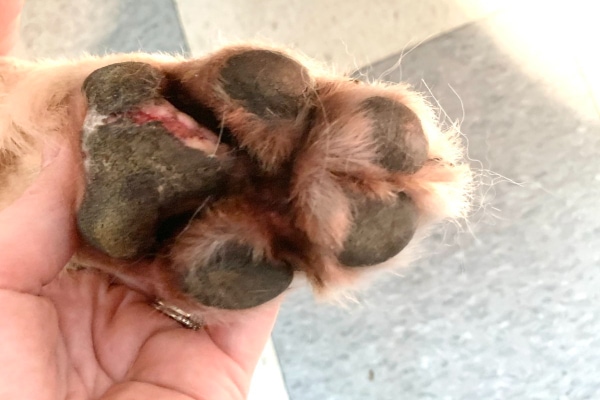Dog Paw Yeast Infection Causes Symptoms and Treatments Guide

Dog owners know their furry friends bring endless joy, but they can also face health challenges. One common issue is a dog paw yeast infection, a frustrating condition that causes discomfort. If your dog is licking their paws excessively or you notice a strange smell, you might be dealing with yeast infection dog paws. Left untreated, these infections can worsen, making your pet miserable.
This article dives deep into dog paw yeast infections, covering causes, symptoms, treatments, and prevention. Whether you’re a new pet parent or a seasoned one, you’ll find practical advice to help your dog stay healthy. Let’s explore how to recognize, treat, and prevent yeast infections on dogs’ paws so your pup can get back to wagging their tail.
Understanding Dog Paw Yeast Infections
What is a Yeast Infection on Dogs’ Paws?
A dog paw yeast infection occurs when there’s an overgrowth of yeast, typically Malassezia pachydermatis, on a dog’s paws. Yeast is naturally present on a dog’s skin, living in balance with other microorganisms. However, certain conditions can disrupt this balance, leading to yeast infection dog paws.
This overgrowth thrives in warm, moist areas, making paws a prime target. The infection often affects the skin between toes or around paw pads. While not life-threatening, a dog yeast infection paw can cause significant discomfort if ignored. Veterinary sources, like the American Kennel Club, emphasize early intervention to prevent complications (AKC, 2023).
Must Visit: Discover Doctorhub360 com Weight Loss App for Easy Results.
Causes of Dog Yeast Infection Paw
Several factors can trigger a yeast infection on dogs’ paws. Understanding these causes helps you address the root of the problem.
Moisture and Environmental Factors
Paws are prone to staying damp, especially after walks in rain or baths. Wet conditions create a perfect environment for yeast to multiply. Dogs who swim frequently or live in humid climates are at higher risk for dog paw yeast infections. Keeping paws dry is crucial to prevent yeast overgrowth.
Allergies
Allergies, whether to food or environmental triggers like pollen, play a big role in yeast infections. When a dog’s immune system reacts to allergens, it can cause inflammation and excess oil production on the skin. This creates a breeding ground for yeast, leading to yeast infection dog paws. Veterinary dermatologists note that allergies are a leading cause of recurrent infections (Merck Veterinary Manual, 2024).
Weakened Immune System
A dog with a compromised immune system is more susceptible to dog yeast infection paw. Illnesses, stress, or medications like steroids can weaken immunity, allowing yeast to flourish. Regular vet checkups help catch underlying health issues early.
Other Contributing Factors
Poor grooming habits, such as neglecting paw cleaning, can contribute to yeast infections. Hormonal imbalances, like hypothyroidism, may also increase risk. Certain breeds, like Bulldogs or Retrievers, are more prone due to their skin folds or thick fur, which traps moisture.
Must Visit: Doctorhub360.com Sexual Health Guide for Better Living.
Identifying Yeast Infections in Dog Paws
Symptoms of Yeast Infection Dog Paws
Spotting a dog paw yeast infection early makes treatment easier. Here are the most common signs to watch for.
Itching and Licking
Excessive licking or chewing of paws is a hallmark of yeast infection dog paws. Your dog may focus on one paw or all four, trying to relieve the itch. This behavior often worsens at night, disturbing their sleep.
Redness and Swelling
Yeast infections cause inflammation, leading to red, irritated skin. You might notice swelling between toes or around paw pads. In severe cases, the skin may feel warm to the touch.
Odor
A distinct “corn chip” or musty smell is a classic sign of a dog yeast infection paw. This odor comes from yeast overgrowth and is often noticeable even before other symptoms appear.
Other Signs
Hair loss, greasy skin, or cracked paw pads can also indicate a yeast infection on dogs’ paws. In chronic cases, the skin may thicken or darken, signaling a need for immediate veterinary care.
Diagnosing a Yeast Infection in Your Dog’s Paws
If you suspect a dog paw yeast infection, consult a veterinarian for an accurate diagnosis. Vets use several methods to confirm yeast overgrowth. A physical exam checks for redness, odor, and skin changes. Skin scrapings or cytology tests, where cells are examined under a microscope, identify Malassezia yeast.
In some cases, vets may test for underlying allergies or health conditions. A proper diagnosis ensures the right treatment plan, preventing recurring yeast infection dog paws (Veterinary Partner, 2024).
Must Visit: DoctorHub360.com Weight Loss Plan: Achieve Sustainable Results.
Treating Dog Paw Yeast Infections
Effective Treatments for Dog Paw Yeast Infection
Treating a dog yeast infection paw requires a combination of veterinary care and at-home management. Here’s how to tackle it effectively.
Topical Treatments
Topical antifungal products are the first line of defense for yeast infection on dogs’ paws. Medicated shampoos, wipes, or creams containing ingredients like miconazole or chlorhexidine target yeast directly. Bathe your dog’s paws regularly, following your vet’s instructions.
For best results, clean paws thoroughly and dry them completely before applying treatments. Consistency is key—daily application may be needed for weeks to clear the infection. Always use pet-safe products, as human antifungals can harm dogs.
Oral Medications
Severe or persistent dog paw yeast infections may require oral antifungal drugs, like ketoconazole or fluconazole. These medications work systemically to reduce yeast levels. However, they can cause side effects, such as liver strain or nausea, so vets monitor dogs closely during treatment.
Oral medications are typically prescribed for 2–4 weeks, depending on the infection’s severity. Follow your vet’s dosage instructions carefully to avoid complications (Cornell University College of Veterinary Medicine, 2023).
Must Visit: Doctorhub360.com Amino Acids: Unlocking the Building Blocks of Health.
Home Remedies (With Caution)
Some pet owners explore natural remedies for yeast infection dog paws, but caution is essential. Diluted apple cider vinegar rinses or probiotic supplements may help balance skin flora, but they’re not a substitute for veterinary care. Always consult your vet before trying home remedies, as improper use can worsen the infection.
For example, undiluted vinegar can irritate sensitive skin, delaying healing. Your vet can guide you on safe, complementary options to support treatment.
Managing Underlying Causes
Treating the infection is only half the battle. Addressing underlying causes prevents recurring yeast infections on dogs’ paws.
Addressing Allergies
If allergies are driving the dog paw yeast infection, identifying triggers is crucial. Your vet may recommend allergy testing to pinpoint food or environmental culprits. Switching to a hypoallergenic diet or using antihistamines can reduce inflammation and yeast overgrowth.
For environmental allergies, limit exposure to pollen or dust by wiping paws after outdoor time. Regular baths with hypoallergenic shampoos also help.
Improving Immune Health
A strong immune system fights yeast naturally. Feed your dog a balanced diet rich in omega-3 fatty acids, which support skin health. Regular exercise and stress reduction, like providing a calm home environment, boost immunity. Annual vet visits catch health issues before they weaken your dog’s defenses.
Must Visit: Doctorhub360.com Neurological Diseases: Expert Insights & Care.
Preventing Future Infections
How to Prevent Yeast Infections in Dog Paws
Prevention is the best way to keep your dog free from yeast infection dog paws. These proactive steps reduce the risk of recurrence.
Keeping Paws Dry and Clean
Moisture is yeast’s best friend, so dry paws are a must. After walks, baths, or swims, towel-dry your dog’s paws thoroughly, especially between toes. In humid climates, consider using a pet-safe powder to absorb excess moisture.
Clean paws regularly with pet-safe wipes or a mild antiseptic solution. This removes dirt and allergens that contribute to dog yeast infection paw.
Regular Grooming
Grooming plays a big role in preventing yeast infections on dogs’ paws. Trim the hair around paw pads to improve airflow and reduce moisture buildup. Check paws weekly for signs of irritation or odor, catching issues early.
For longව
Regular baths with a gentle, vet-recommended shampoo keep skin clean and reduce yeast-friendly environments.
Dietary Considerations
A healthy diet supports skin and immune health, lowering the risk of dog paw yeast infections. Avoid foods high in carbohydrates or sugars, as yeast thrives on these. Opt for high-quality, low-carb dog food, ideally with input from your vet.
If food allergies are a concern, try a limited-ingredient diet to identify triggers. Adding omega-3 supplements, like fish oil, can reduce inflammation and promote healthy skin (PetMD, 2024).
Environmental Management
Control your home’s humidity with a dehumidifier, especially in damp climates. Wash bedding regularly to remove allergens and yeast spores. During walks, avoid grassy areas where pollen or mold may trigger allergies, which can lead to yeast infection dog paws.
Using booties during wet weather keeps paws dry and protects against irritants. Choose breathable, well-fitting booties to avoid trapping moisture.
Must Visit: Doctorhub360 com Weight Loss Login: Your Personalized Solution
Conclusion
A dog paw yeast infection can make your furry friend uncomfortable, but with the right knowledge, you can tackle it effectively. By recognizing symptoms like itching, redness, or a musty odor, you can act quickly to treat yeast infection on dogs’ paws. Topical or oral treatments, combined with addressing underlying causes like allergies or moisture, help clear the infection.
Prevention is just as important. Keep paws dry, groom regularly, and feed a balanced diet to reduce the risk of dog yeast infection paw. If symptoms persist, consult your veterinarian for tailored advice. With proactive care, your dog can enjoy healthy, happy paws and a better quality of life.
For more Informative Blogs, visit doctorhub360.net.
